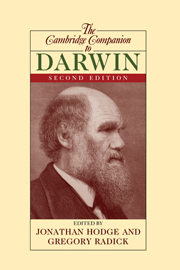Book contents
- Frontmatter
- Introduction
- Part I Darwin’s theorising
- Part II Historical contexts
- Part III Current issues
- Part IV Philosphical prospects
- 16 In Darwin’s wake, where am I?
- 17 Ethical expressions: why moralists scowl, frown and smile
- 18 Is human nature natural?
- 19 Giving Darwin his due
- Guide to further reading
- List of references
- Index
17 - Ethical expressions: why moralists scowl, frown and smile
from Part IV - Philosphical prospects
Published online by Cambridge University Press: 28 May 2009
- Frontmatter
- Introduction
- Part I Darwin’s theorising
- Part II Historical contexts
- Part III Current issues
- Part IV Philosphical prospects
- 16 In Darwin’s wake, where am I?
- 17 Ethical expressions: why moralists scowl, frown and smile
- 18 Is human nature natural?
- 19 Giving Darwin his due
- Guide to further reading
- List of references
- Index
Summary
A major task for philosophy is to adjudicate conflicts between our ordinary way of understanding persons and the world - what Wilfrid Sellars called the 'manifest image' - and scientific accounts of persons and the world - the 'scientific image'. Sometimes, of course, it is possible to blend the two images so as to produce a genuinely stereoscopic or synthetic picture. But this is not always possible. In the case of Darwin's theory of natural selection, we seem to have a scientific theory that cannot be comfortably assimilated into the extant manifest image by adding, in Sellars' phrase, a 'needle point of detail' to that image. As traditionally understood, we humans are made in God's image and sit beneath God and the angels and above the animals on the 'Great Chain of Being'. There is a tripartite ontology of Pure Spirit(s) (God and angels), pure matter (rocks, plants and animals), and dualistic beings who, while on earth, partake of both the immaterial realm and the material realm (us). We humans know the material realm through our senses and reason, and the immaterial realm - theological and moral truths in particular - through illumination, grace or other non-empirical and nonrational or arational means. God sets out the moral law, and if we obey it, thereby using our free will properly, we will gain eternal salvation.
- Type
- Chapter
- Information
- The Cambridge Companion to Darwin , pp. 413 - 434Publisher: Cambridge University PressPrint publication year: 2009
- 2
- Cited by



